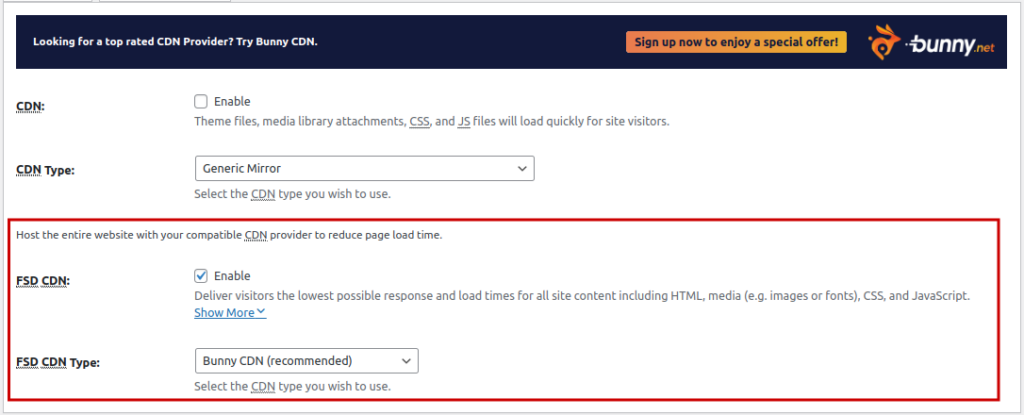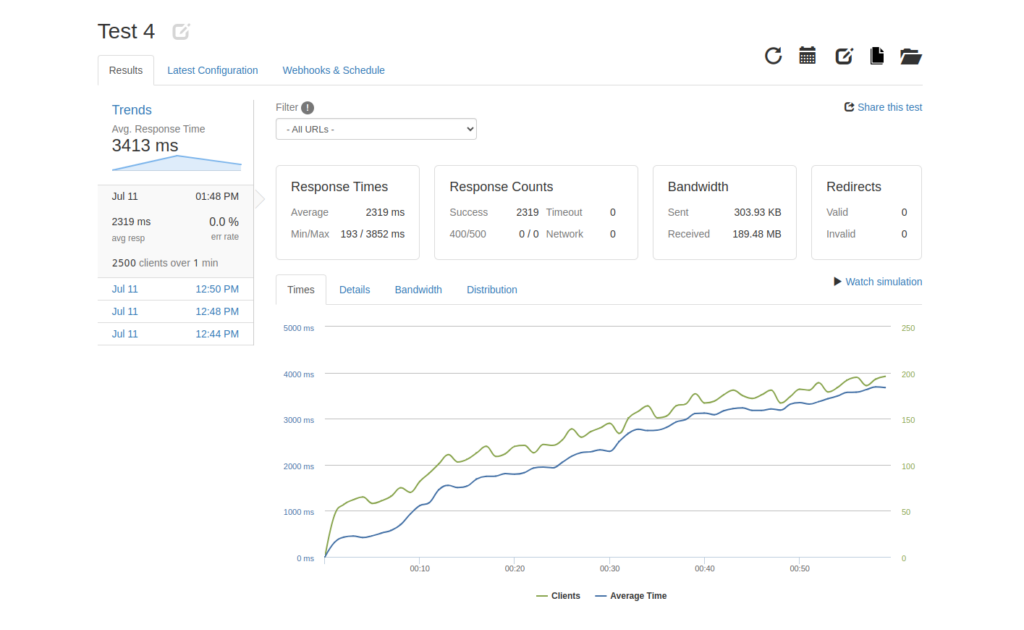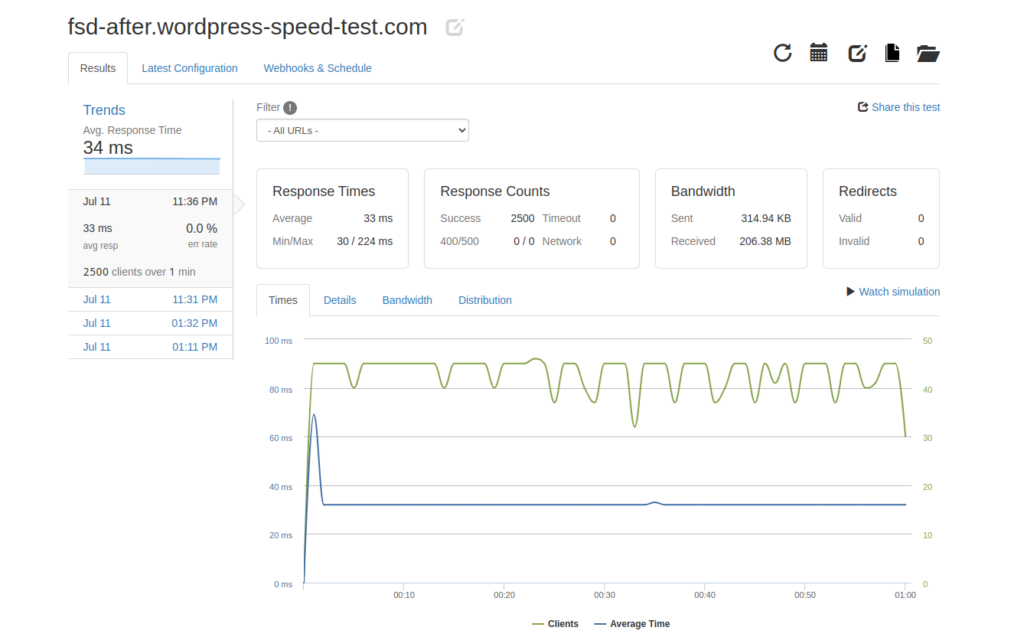
In this Loader.io Experiment, we’re testing W3 Total Cache’s Full Site Delivery pro feature with hopes of better understanding the impact of this feature on website performance and speed.
In this test, using the W3 Total Cache Full Site Delivery (FSD) feature added a 99% performance enhancement to the Average Server Response Time! Read the documentation to learn how to use the Full Site Delivery (FSD) pro feature.
Upgrade to W3 Total Cache Pro and improve your PageSpeed Scores today!
Understanding Full Site Delivery and It’s Impact on Website Performance
Control Website
Our control website is a simple installation. We’re using the Twenty Twenty-Four WordPress theme with no other plugins or custom functionalities enabled. The purpose of the control website is to get an accurate reading of the site’s page load scores before adding W3 Total Cache and enabling the Full Site Delivery feature.
Control Website: https://wordpress-speed-test.com/060524/
Experimental Website
We duplicated our control website into a new sub domain to create a new experimental website that mirrors the original one, so we can test the load averages of the two sites side by side.
Experimental Website: https://fsd-after.wordpress-speed-test.com/
In this test, using the W3 Total Cache Full Site Delivery (FSD) feature added a 99% performance enhancement to the Average Server Response Time! Read the documentation to learn how to use the Full Site Delivery (FSD) pro feature.
Upgrade to W3 Total Cache Pro and improve your PageSpeed Scores today!
Experimental Website Setup
We chose to enable Bunny CDN, our recommended FSD network, from the W3 Total Cache “General Settings” dashboard and ensured that it was authorized and functioning properly on the experimental site.
You can confirm Bunny CDN and Full Site Delivery are enabled from the CDN section. At the very top of the page, look for the full-site-delivery message and make sure that FSD CDN support is enabled and authorized.
If you scroll down a bit on this page, you’ll see the Configuration: Full-Site Delivery section. This section contains information from the Bunny CDN Pull Zone we just created.
With this method, we hope to compare the performance of both websites directly, giving us valuable insights into the real benefits of using the Full Site Delivery pro feature from W3 Total Cache. Review the results of our testing below.
Test 1: Simulate Heavy Traffic Using Loader.io
To understand the impact of Full Site Delivery (FSD) under heavy traffic, we conducted simultaneous tests on both the control and experimental sites using Loader.io. Our goal was to evaluate the average server response time and server load under intense traffic conditions. The test simulated 2,500 clients making the same server request within a 60-second time span.
Control Website Results
- Test Conditions: 2,500 clients over 60 seconds
- Average Response Time: 3,413 ms
- Successful Requests: 2,319 out of 2,500
All visitors were able to make their requests without any errors. However, due to the high average response time, only 2,319 requests were completed within the 60-second interval.
Server Load: We also recorded the load average on the server and created a chart to illustrate the impact of the test on the server load. You’ll notice a steady climb in load averages as the test progresses and more client requests are made.
The load average on the server increased steadily as more client requests were made. This climb in load average indicates the server’s struggle to handle the increasing number of requests.
Experimental Website Results with Full Site Delivery
- Test Conditions: 2,500 clients over 60 seconds
- Average Response Time: 34 ms
- Successful Requests: 2,500 out of 2,500
Similarly, all visitors to the experimental site made their requests successfully without errors. Notably, the response time for each request was much faster, averaging only 34 ms. The experimental site handled all 2,500 requests within the 60-second interval, showcasing the efficiency of Full Site Delivery.
Server Load: Unlike the control site, the load average on the experimental site decreased over time. This indicates that the requests were processed by the Full Site Delivery CDN rather than the origin server, significantly reducing the server’s load.
Key Takeaways
- Significant Reduction in Response Time: The experimental site’s average response time of 34 ms compared to the control site’s 3,413 ms demonstrates the dramatic improvement in performance due to Full Site Delivery.
- Higher Request Handling Capacity: The experimental site completed all 2,500 requests within the 60-second period, whereas the control site fell short, handling only 2,319 requests. This indicates better scalability and efficiency with FSD.
- Reduced Server Load: The experimental site’s server load decreased during the test, in contrast to the control site’s increasing load. This highlights the effectiveness of Full Site Delivery in offloading traffic to the CDN, ensuring the origin server remains stable and efficient.
The Loader.io test results clearly show the benefits of implementing Full Site Delivery with Bunny CDN. By reducing response times and server load, FSD ensures your website can handle heavy traffic with ease, maintaining fast load times and high reliability. This improved performance not only enhances the user experience but also provides greater scalability and stability for your website.
In this test, using the W3 Total Cache Full Site Delivery (FSD) feature added a 99% performance enhancement to the Average Server Response Time! Read the documentation to learn how to use the Full Site Delivery (FSD) pro feature.
Upgrade to W3 Total Cache Pro and improve your PageSpeed Scores today!
Test 2: Testing Website load time from Different geographical locations
To showcase the tangible improvements that Full Site Delivery (FSD) can bring, we conducted Pingdom speed tests, focusing on the impact of geographical proximity on load times. Our web server is located in Virginia, and we tested the performance from London before and after implementing FSD.
Baseline Test: Control Site Without Full Site Delivery
Before implementing FSD, the London server had to connect directly to our web server in Virginia. This significant geographical distance resulted in longer load times due to the increased latency. Users in London experienced slower page load speeds because data had to travel across the Atlantic, highlighting the limitations of relying solely on an origin server for content delivery.
In our initial test, we measured the performance of the control site without FSD. The key metrics were as follows:
- Location: London
- Number of Requests: 19
- Load Time: Approximately 23 seconds
This longer load time is due to the geographical distance between the London server and our web server located in Virginia. The data had to travel across the Atlantic, resulting in higher latency and slower page load speeds.
Improved Performance: Experimental Site With Full Site Delivery
Next, we tested the experimental website, which was configured with Full Site Delivery via Bunny CDN and optimized using W3 Total Cache. The results were striking:
- Location: London
- Number of Requests: 19 (same as the control site)
- Load Time: Under 1 second
With Full Site Delivery, the London server connected to a nearby CDN edge server rather than the distant origin server in Virginia. This significant reduction in load time—less than 1 second compared to almost 23 seconds—demonstrates the profound impact of FSD on website performance.
Key Takeaways
- Same Number of Requests, Drastically Different Load Times: Despite handling the same number of requests (19), the experimental site’s load time was dramatically reduced thanks to FSD.
- Geographical Proximity Matters: By leveraging Bunny CDN’s edge servers, the data did not have to travel as far, which minimized latency and enhanced loading speed.
- Enhanced User Experience: The reduction in load time to under 1 second provides a significantly better user experience, encouraging visitors to stay on the site, engage with content, and reduce bounce rates.
The Pingdom speed test results from London highlight the substantial improvements in load times and overall performance when using Full Site Delivery with Bunny CDN. By bringing the website’s content closer to users through edge caching, we achieved a load time of under 1 second, compared to the 23 seconds it took for the control site. This demonstrates how Full Site Delivery not only improves site reliability and speed but also enhances user engagement and satisfaction across different regions.
Final Thoughts
Implementing Full Site Delivery with W3 Total Cache and Bunny CDN is a strategic move for any website owner looking to enhance their site’s performance, user experience, and SEO. The substantial improvements observed in our experiment underscore the potential benefits of this approach.
We encourage you to explore the Full Site Delivery feature and experience these benefits firsthand. For detailed instructions on setting up Full Site Delivery, refer to the official documentation and leverage the resources available to optimize your website’s performance effectively.
By investing in these technologies, you can ensure your website is not only fast and reliable but also well-positioned for growth and success in the competitive online landscape.
W3 Total Cache
You haven't seen fast until you've tried PRO
Full Site CDN + Additional Caching Options
Advanced Caching Statistics, Purge Logs and More
Everything you need to scale your WordPress Website and improve your PageSpeed.









